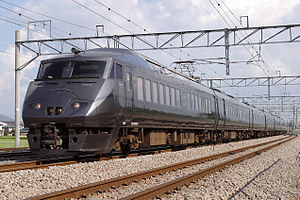787 series (JR Kyushu)
| 787 series | |
|---|---|
 787 series set BM5 on the Kagoshima Main Line, September 2009 | |
| In service | July 1992–Present |
| Manufacturer | Hitachi, Kinki Sharyo |
| Built at | Kudamatsu, Higashiōsaka |
| Replaced | 485 series |
| Constructed | 1992 - 2002 |
| Number in service | 140 vehicles (26 sets) |
| Formation | 4/6/7 cars per trainset |
| Fleet numbers | BM1-15, BM101-111 |
| Operators | JR Kyushu |
| Depots | Ōita, Minami-Fukuoka |
| Specifications | |
| Car body construction | Steel |
| Car length | 21,200 mm (end cars) 20,000 mm (intermediate cars) |
| Width | 2,944 mm |
| Doors | 1 per side |
| Maximum speed | 130 km/h (80 mph)*[1] |
| Traction system | Thyristor drive |
| Electric system(s) | 20 kV AC 60 Hz |
| Current collector(s) | Overhead catenary |
| Bogies | DT400K(powered), TR400K(trailer) DT901K(powered), TR901K(trailer)(prototype bogie) |
| Safety system(s) | ATS-SK |
| Track gauge | 1,067 mm (3 ft 6 in) |
The 787 series (787系) is an AC electric multiple unit type operated on limited express services by Kyushu Railway Company (JR Kyushu) in Japan since July 1992.[1]
Design
The trains were built jointly by Hitachi and Kinki Sharyo.[2]
Formations
7-car sets (BM1–11, BM1–14)
The 7-car sets are formed as follows.[3][4]
| Car No. | 1 | 2 | 3 | 4 | 5 | 6 | 7 |
|---|---|---|---|---|---|---|---|
| Designation | Msc | M'1 | T1 | T2 | T | M | M'c |
| Numbering | KuMoRo 787 | MoHa 786 | SaHa 787-100 | SaHa 787-200 | SaHa 787 | MoHa 787 | KuMoHa 786 |
Cars 2 and 7 are each fitted with one PS400K scissors-type pantograph.
6-car sets (BM12, BM115)
The two 6-car sets are formed as follows.[3][4]
| Car No. | 1 | 2 | 3 | 4 | 5 | 6 |
|---|---|---|---|---|---|---|
| Designation | Msc | M'1 | T2 | T | M | M'c |
| Numbering | KuMoRo 787 | MoHa 786 | SaHa 787-200 | SaHa 787 | MoHa 787 | KuMoHa 786 |
Cars 2 and 6 are each fitted with one PS400K scissors-type pantograph.
4-car sets (BM101–BM111)
The 11 4-car sets are formed as follows.[3][4]
| Car No. | 1 | 2 | 3 | 4 |
|---|---|---|---|---|
| Designation | Thsc | M | M' | Tc |
| Numbering | KuRoHa 786 | MoHa 787 | MoHa 786 | KuHa 787 |
Car 3 is fitted with one PS400K scissors-type pantograph.
Operations
As of March 2011, the 787 series are used on the following limited express services.[4]
From the start of the revised timetable on 12 March 2011, with the completion of the Kyushu Shinkansen, 787 series sets will no longer be used on Relay Tsubame services. The T1 (SaHa 787) cars will be removed from the 7-car sets to form a fleet of 15 6-car sets. These will be used on Kamome services, displacing the earlier 783 series EMUs.[4]
History
All cars were made no-smoking from the start of the revised timetable on 18 March 2007.[3]
See also
![]() Media related to 787 series at Wikimedia Commons
Media related to 787 series at Wikimedia Commons
References
- ^ a b JR全車輌ハンドブック2009. Japan: Neko Publishing. 2009. ISBN 978-4-7770-0836-0.
{{cite book}}: Unknown parameter|trans_title=ignored (|trans-title=suggested) (help) - ^ Saka, Masahiro (March 2014). "JR第1世代の車両・現況と概要". Tetsudō Daiya Jōhō Magazine (in Japanese). 43 (359). Japan: Kōtsū Shimbun: 22.
{{cite journal}}: Unknown parameter|trans_title=ignored (|trans-title=suggested) (help) - ^ a b c d JR電車編成表 2010夏. Japan: JRR. May 2010. pp. 202–203. ISBN 978-4-330-14310-1.
{{cite book}}: Unknown parameter|trans_title=ignored (|trans-title=suggested) (help) - ^ a b c d e "JR九州 新幹線・特急列車の運転体系概要". Tetsudō Daiya Jōhō Magazine. 40 (323). Japan: Kōtsū Shimbun: 28–31. March 2011.
{{cite journal}}: Unknown parameter|trans_title=ignored (|trans-title=suggested) (help)

